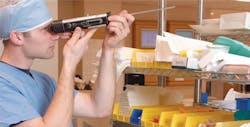Single-use endoscopes: Pop fly or home run in cleaning, sterilization?
One of the latest wrinkles in the proper reprocessing of endoscopes doesn’t even involve reprocessing them at all – or recycling for that matter.
Amid scores of media headlines that reveal either negligence or malfeasance when it comes to effective reprocessing protocols, several companies have emerged offering “disposable” or “single-use only” endoscopes.
As with any strategy and tactic, deciding to go in either direction carries with it a set of consequences – the good, the bad and sometimes the ugly – that can be obvious (playing the short ball) and not-so-obvious (playing the long ball).
The degree to which a healthcare organization adds single-use-only endoscopes into its mix remains ripe for debate. But observers with whom Healthcare Purchasing News spoke seemed to agree on one thing: Switching to single-use-only endoscopic devices in whole or in part may not be the most prudent strategy to adopt and implement. See sidebar below.
Scoping out viable SPD solutions
To maintain quality productivity in sterile processing, Healthcare Purchasing News asked sterile processing experts to rank the following five strategies (1 being the most important/influential; 5 being the least important/influential).
| Strategy | Average score: |
|---|---|
| Thoroughly educating, training and vetting SPD staffers on proper and effective cleaning techniques | 1.5 |
| Demanding, receiving and following validated instructions for use (IFUs) | 2.5 |
| Holding staffers accountable/responsible for endoscope cleaning “violations” | 2.8 |
| Comprehensively monitoring and tracking all steps in the process with sensors and video technology | 3.4 |
| Switching to single-use-only endoscopic devices | 4.8 |
Observers were allowed to suggest other alternatives. Here’s what they added:
“Implementing cleaning verification and inspection steps across the board for all scopes. Many facilities still don’t do this.”
“Hospital administration support: The sterile processing departments that receive strong C-suite support are the ones that deliver the highest quality sterile processing results. Often that relationship starts with SPD proactively pulling them into the department to educate leaders on the detailed, tedious process required to deliver high-quality reprocessed instruments. Opening this line of communication has a significant impact on how the operation is viewed and increases the likelihood of sufficient financial support.”
“Sterilize endoscopes using the only FDA-cleared and validated H2O2/ozone sterilizer. Sterilization of these scopes should be the standard of care for patients for every endoscope, including duodenoscopes, colonoscopes and gastroscopes.”
“All of the above are solutions to maintain quality and productivity in sterile processing. I would eliminate the word ‘demanding’ and replace it with ‘requiring.’ IFUs should always be required prior to cleaning, high-level disinfection or sterilization. Thorough education and training is essential. This is equally important to required and completed IFUs. Monitoring and tracking all steps should be replaced with validating the cleanliness of endoscopes prior to high-level disinfection or sterilization. If it’s not clean, it cannot reliably be disinfected or sterilized. We should also consider increasing pay levels within SPD and pay for performance programs.
Overt, covert pros
From patient service to clinical quality to budgetary concerns, the motivation behind single-use-only endoscopes spans the overt to the covert.
“The most obvious and important pro is that a single-use wrapped sterilized endoscope is available for each patient which mitigates infection risk,” said Mary Ann Drosnock, FAPIC, CIC, CFER, RM (NRCM), Senior Manager of Clinical Education, Healthmark Industries. “There may be a reduction in overall costs because the endoscope is not cleaned and disinfected or sterilized between uses. This may include a reduction in chemical, equipment and even salary costs. Also, there is no risk of using an endoscope that is in a poor condition because each endoscope is new. That aspect mitigates patient safety risks.”
Minerva Lorán, President, Clinical Choice LLC, agrees.
“The obvious pros include patient safety, time and capital savings,” Lorán said. “Sterile single-use endoscopes should eliminate reusable endoscope-related infections. There are several operational and capital costs that will be eliminated, including bedside and post-procedure cleaning, disinfection and storage. If disposable endoscopes are capable of reusable endoscope performance, they are worth consideration.”
Lorán also points out the reduction of internal and external logistics associated with reusable endoscopes, including procedure, cleaning and reprocessing staff internally and the coordination of repair, loaners and overall inventory tracking externally.
Dan Gusanders, President, Pure Processing, stresses the element of trust all around – from supplier to provider to end user.
“When used properly and discarded after one use, single-use endoscopes have the potential to reduce acquired infections,” Gusanders said. Successful infection reduction still depends on following all manufacturer instructions and handling the endoscope properly when unpacking and during procedures. It also assumes that each device has completed validated sterilization by the manufacturer.”
Ultimately, the decision can eliminate cross-contamination, reprocessing and repairs, according to Rick Schultz, President, RMPS Publishing LLC, a renowned expert on surgical instrumentation, former CEO, Spectrum Surgical Instruments, which is part of STERIS via the Integrated Medical Systems International acquisition six years ago. In that regard, there’s minimal variance to general surgical instrument migration to single-use devices, which should provide consistent quality, said Schultz, author of the industry guidebook, “The World of Surgical Instruments.”
“Removing all patient infection risk associated with endoscope reuse would eliminate many risk factors from all areas of the endoscope utilization, cleaning, and maintenance life cycle,” indicated Melissa Kubach, Educator/Quality Manager,
Unitas Medical Services Inc., a Mobile Instrument Service & Repair company. This includes the reduction of patient cross contamination and infection risks originating from flexible endoscope devices, she added.
Kubach encourages examining the total costs of adding single-use-only endoscopes into the device mix, taking into account the overall potential cost reduction associated with reusable devices, depending on usage and price point.
“True cost analysis for all associated costs including risk reduction, purchase, maintenance, reprocessing and supplies would need to be examined closely,” she added.
Single-use models should minimize device integrity concerns, according to Pika Lynch, RN, Director, Clinical Services, TSO3 Corp.
“Using a new device on every patient reduces likelihood of device malfunction due to wear and tear,” she noted. Plus, single-use devices obviate the need for preventive maintenance concerns and traceability, she added.
Further, imagine the potential savings if the procedural costs could be transferred to the case charge, Kubach continued. “This could be justified if enough cost savings could be realized by the payer,” she noted. “Items that have historically been considered procedurally low-risk and reusable have been difficult to gain approval for transference.”
Bringing in single-use-only endoscopes also may reduce inventory for reprocessing supplies, such as AER and chemical products, according to Kubach. “This is especially poignant for high-level disinfection chemicals, automated endoscope reprocessors and flexible endoscope sterilization needs,” she emphasized. “This would also greatly eliminate risk related to chemical exposure.”
The revenue component could be striking, too, from a convenience standpoint, Kubach said. “With the elimination of equipment processing, inventory shortages and improved case turnover, more cases could be scheduled daily as well as reduce patient scheduling delays,” she added.
Healthmark’s Drosnock recognizes the potential scheduling gains as well as staff safety measures from reduced exposure to toxic materials.
“There may be a decreased turn-around-time between procedures since there is no reprocessing of the endoscope between uses,” Drosnock noted. “In facilities where inventory levels may not be optimal, and procedures wait on a scope to be processed, implementation of single-use endoscopes may lead to better scheduling. Additionally, decreased use of processing chemicals can reduce the environmental impact of the facility, reduce exposure risks to staff, reduce water usage, and even reduce use of other single-use items that may be used in endoscope reprocessing.”
Single-use-only endoscopes may enable healthcare organizations to reduce their capital investment and “up front” costs for equipment, as well as maintenance and repair costs, including operational downtime, according to Schultz. Plus, SPD wouldn’t have to manage loaner stock or worry about cleaning brush expenditures, he added.
Unitas’ Kubach points to paperwork and public perception/publicity as peripheral benefits of the transition to disposable products.
“Removing the reprocessing portion of this program would reduce a large portion of current regulatory standards and recommendations,” she said. “And increased patient anxiety related to publicized reusable devices would be moot.” Single-use-only devices would negate the presence of residual simethicone, a cloudy, viscous fluid that can remain inside the lumens and ports of fully reprocessed endoscopes, after being used to improve visualization in body cavities during surgery, she added.
Overt, covert cons
Observers note that costs may represent the steepest hurdle in migrating to single-use-only endoscopes from reusable models. Specifically, some contend that the per-unit cost of a single-use-only endoscope, calculated in bulk, may exceed the per-unit costs of a reusable endoscope, along with the associated costs involved in reprocessing it. Others argue that what may be eliminated in reprocessing costs may be offset by increased waste disposal costs as these devices would balloon the volume of more costly red-bagged medical waste.
”Cost is the main perceived con associated with single-use endoscopes,” Drosnock acknowledged. “There may be an increased overall equipment cost associated with the purchase of single-use endoscopes dependent on their individual unit cost. It is unknown whether the decreased cost of reprocessing an endoscope and associated salary reductions would off-set the cost of purchase of single-use units. Reimbursement for procedures may not increase to alleviate the higher associated costs,” she added.
Pure Processing’s Gusanders echoes the cost claims from conversion, emphasizing the environmental challenges as well as the trust factor in a different light.
“Single-use devices can be cost prohibitive for many providers,” he noted. “Daily inventories of these devices must be proactively available, which requires ongoing ordering and expense regardless of the facility’s revenue fluctuations.
“There is also environmental damage associated with single-use instruments,” Gusanders continued. “They add an ever-increasing volume of daily medical waste to our environment as the number of surgical and diagnostic procedures continues to increase. Although there are numerous local or regional recycling programs and companies, many only recycle a few component materials or types of medical waste, and the costs and effort of recycling appear to fall heavily on healthcare systems and providers.”
But Gusanders also raises the questionable behavior surrounding any product designated “single-use-only” that persists despite legal warnings to the contrary.
“Some facilities have been reprocessing and re-using some single-use devices for economic reasons, which is an off-label use,” he noted. “Although regulating agencies and guidance bodies recognize this fact, they typically also state a preference for using these devices per their IFU.”
Kubach expresses concerns about the costs of single-use-only models, urging facilities to “look closely at the math and weight it against per-patient disposable cost incurrence.”
But she also casts doubts on market competition and technological development.
“With minimal manufacturer choices, both long-range pricing stability and ancillary cost increases, such as loss of discount from current manufacturer for purchased disposable therapy accessories, would need to be considered,” Kubach observed.
She further worries about product advancement suffering, which will affect quality and performance. “There have been advances with light technologies, focus capabilities and anatomical tracking that most likely will not equally translate to the disposable version,” Kubach noted. “Image and material quality could greatly impact physician performance and patient outcomes.”
TSO3’s Lynch questions the functional limitations that single-use-only models may offer with the effects on economics and patient care quality.
“Single use devices cannot be produced economically with the same technology and level of functionality,” she observed. “[This] limits technological advances because industry would see it as not cost effective to make adjustments, and may limit quality of diagnostic procedures with substandard technology.”
As a result, ORs will have to consider the possibility of less-than-100-percent device performance reliability, which may delay disease detection until later stages, Lynch emphasized.
Lynch also surmises that the total cost-per-patient may increase from the use of single-use-only endoscopes, as well as the costs for hazardous medical waste treatment and disposal.
Drosnock concurs that technological issues may affect overall utility and procedural assignment.
“The facility may need to purchase new light sources, processors and towers to use with the new single-use scopes, which would represent a one-time capital cost expenditure,” she cautioned. “These endoscopes may not be of the same technological capabilities, feel or maneuverability as ones that the physicians are already used to using. Therefore, there may be lack of buy-in from other members of the team. It is a potential that the single-use scopes may have a capability of only being used in diagnostic procedures and that a traditional reprocessed endoscope would need to be used in the case of a therapeutic procedure.
“Many unknowns exist regarding the implementation of single-use endoscopes and details will be different for each facility based on their particular circumstances, logistics and workflow,” she concluded.
While Gusanders targets the added facility expenses, logistics and space requirements attached to medical waste disposal of these single-use-only devices, he worries about market development and the ripple effect on patient care.
“A reprocessing market for single-use devices may develop that is unregulated and poses patient safety risks,” he indicated. “Reprocessed single-use instruments could be sold and used in less developed areas with poor or no standards in place.”
Schultz also questions the durability of single-use-only endoscopes when compared to reusable models, and how surgeons will react to using them as the single-use models will offer a “different feel” for the surgeon.
Kubach recognizes similar issues around product quality and physician satisfaction. “Physicians most certainly would have varying opinions depending on their perception of the disposable products’ quality,” she noted. In addition, the faster, improved turnover rates of surgical cases may have a detrimental effect.
“Case outcomes can be affected by many variables with large increases in daily procedures potentially leading to physician and staff fatigue, reduced detection rates and increased patient safety risk,” she surmised.
The domino effect hits SPD staffing, too, according to Kubach. “With less need for additional hands [for reprocessing], the staff would most certainly be impacted.”
Clinical Choice’s Lorán reflects on the challenges that single-use-only models pose, centering like others on performance, cost and waste.
“Disposable endoscopes, while attractive, must equal or exceed the performance of reusable endoscopes,” she said. “Procedural outcomes must be equal to that of reusable endoscopes, and cost should decrease. Waste is a significant concern. Reusable endoscopes can, for the most part, be recycled. Disposable endoscopes, if truly single-use and not capable of being recycled for a limited number of uses, will increase waste in our landfills.
Lorán also expresses concern about the effects on physician workflow, specifically “the inability of physicians to maximize procedural outcomes due to mechanical and optical performance,” and logistical expanse in terms of “the sheer number of disposable endoscopes that would need to be stocked. Inventory rooms and logistics would increase to ensure there is an endoscope for every procedure,” she added.
SCOPES:
Reusable endoscopes: Tried and true for cleaning
Tips, tools and tricks for inspecting properly cleaned endoscopes
If you’re being scoped, shouldn’t that scope be tested first?
About the Author
Rick Dana Barlow
Senior Editor
Rick Dana Barlow is Senior Editor for Healthcare Purchasing News, an Endeavor Business Media publication. He can be reached at [email protected].






